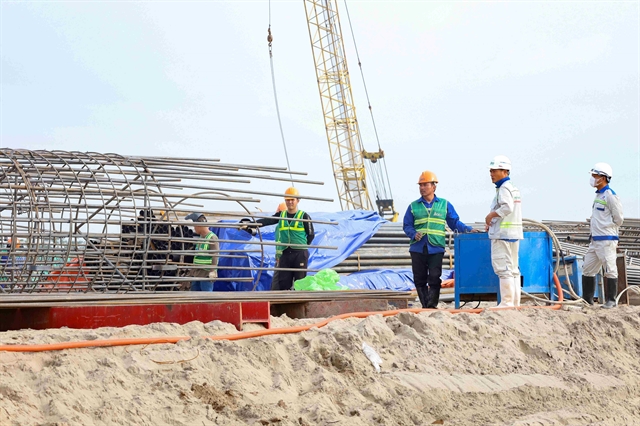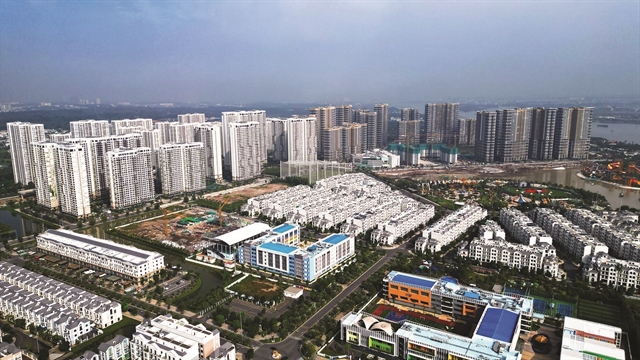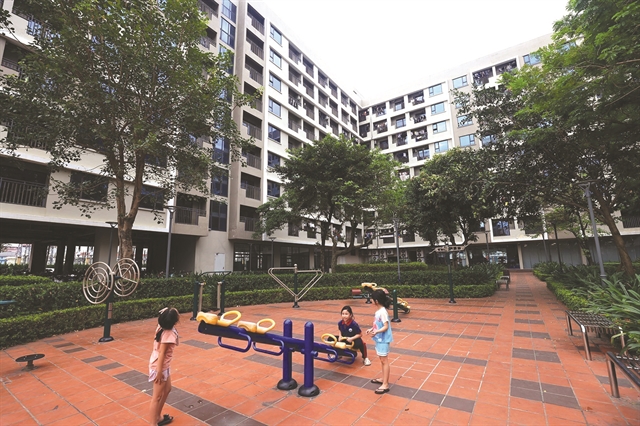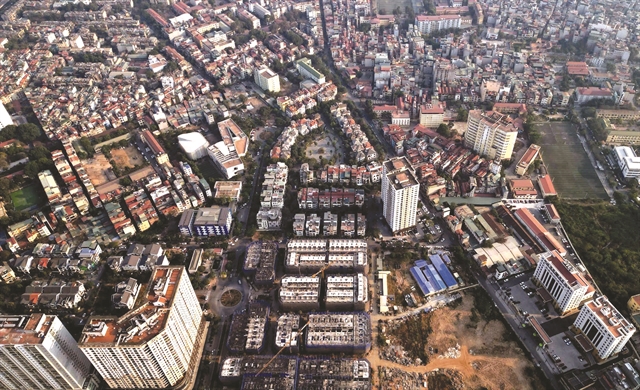 Economy
Economy

 |
| A bird view of a corner in HCM City. The Government is weighing a plan to develop so-called affordable commercial housing to boost supply and stabilise the overheated real estate market. VNA/VNS Photo Tuấn Anh |
As Việt Nam grapples with soaring housing prices, the Government is weighing a plan to develop so-called affordable commercial housing aimed at boosting supply and stabilising the overheated market.
However, as details of the proposal emerge, experts are urging the policy to be carefully designed to ensure feasibility and avoid further market distortions.
The proposal appears in a government draft regulation outlining mechanisms to control real estate prices, which the Ministry of Construction has released for public feedback.
Under the draft, provincial and municipal authorities would be required to allocate at least 20 per cent of new commercial housing projects in 2026-30 for affordable commercial housing developments. Such projects would benefit from several preferential policies, including direct selection without bidding, streamlined procedures and land-use fees.
Developers would be allowed a maximum profit margin of 20 per cent of total investment capital while homebuyers would not be permitted to transfer or resell their properties, in line with existing regulations aimed at preventing speculation.
Scarcity
Despite rapid urbanisation, affordable housing remains scarce in major cities, especially in Hà Nội and HCM City, where most new projects target high-end segments.
“The market is witnessing the disappearance of mid-priced and affordable housing and surging prices are pushing the dream of home ownership further out of reach for millions of households,” Lê Hoàng Châu, president of the HCM City Real Estate Association, said.
 |
| A view of Vinhomes Grand Park Urban Area in HCM City. The market is seeing new releases of high-end segment, while affordable housing is gradually disappearing. VNA/VNS Photo Tuấn Anh |
Châu said that no affordable housing projects were developed in HCM City from 2021-24 and more than 3,350 apartment units launched in the first half of this year all belonged to high-end segment.
Across the country, overall housing supply had been rising, but the share of affordable homes remained critically low.
According to Việt Nam Association of Real Estate Brokers, the total new housing supply exceeded 100,000 units in the first nine months of 2025, up 22 per cent from last year. However, only 6 per cent were classified affordable, most of which were social housing – signalling a serious market imbalance.
The Government has set a target of completing 428,000 social housing units by the end of 2025 and over 600,000 more by 2030, a total of more than one million units in the next five years. However, as of September, fewer than 45,000 units had been completed nationwide. Even including those under construction or approved for development, the total is expected to reach just about 85,000 units, still far below the target.
Underscoring the skyrocketing rise in housing prices in major cities, Dương Thuỳ Dung, director of CBRE Việt Nam, said that the Vietnamese property market was experiencing a steep and sustained price escalation with apartment prices setting the highest level ever of up to VNĐ200 million (US$7,600) per square metre.
“Affordable housing has become almost extinct in major cities, worsening market imbalance and pushing up home prices ever higher,” Nguyễn Văn Đính, VARS’s President said.
Đính warned that soaring home prices and the severe shortage of affordable housing were undermining young people’s chances of owning a home, which could have broader demographic consequences and place heavier burdens on healthcare, social welfare, and sustainable economic growth in the years ahead.
According to the Vietnam Real Estate Association, there are numerous challenges hindering the development of affordable commercial housing in Việt Nam, including prolonged legal bottlenecks, rising construction and material costs, regulatory hurdles, weak planning, and lack of credit support.
A critical policy
 |
| A playground at a social housing project in Bắc Ninh Province. Việt Nam plans to develop policies to promote affordable commercial housing. VNA/VNS Photo Tuấn Anh |
"It is urgent for Việt Nam to develop policies to promote affordable commercial housing, together with social housing, to meet the market demand," Châu said.
He said that affordable housing should be divided into two segments: social housing which has the lowest prices and benefits from strong Government support, and affordable commercial housing for those who have real housing needs but are not eligible for social housing.
Châu recalled that in 2013 when the Government introduced a VNĐ30 trillion credit package, commercial homes priced below VNĐ1.05 billion were considered affordable and qualified for preferential loans. Now, affordable commercial housing should be priced at VNĐ3 billion or less.
He suggested expanding the current VNĐ145 trillion credit package for social housing projects and old apartment renovation with lending rate of around 5.9-6.1 per cent, to also include affordable commercial housing.
The most important factor would be credit support for buyers with affordable interest rates and stable loan terms of 20-25 years.
To increase the supply of affordable housing, Châu urged efforts to remove obstacles for 2,890 stalled projects identified by the Prime Minister, ensure fair access to land and simplify administrative procedures to accelerate project approvals.
Lawyer Trương Ngọc Liêu from the Hanoi Bar Association said the current property market showed a sharp imbalance between housing prices and the actual needs of middle-income earners for affordable homes.
At current market rates, only a small group of high-income individuals could afford commercial housing, while social housing remained limited to a narrow group of eligible buyers under existing regulations.
“Therefore, introducing policies to boost the supply of affordable homes is critical for addressing the market gap,” Liêu said.
He added that the proposed mechanisms for “affordable commercial housing” should represent a hybrid policy framework – combining elements of both social housing support and commercial housing development.
The draft regulation, however, had yet to clarify how affordable commercial housing would be defined or what criteria would be used to determine it, Liêu said, adding that without clear guidelines, it would be difficult for the policy to work in practice.
Liêu added that the cap of 20 per cent of total commercial housing projects reserved for affordable units should not be fixed but rather be flexible depending on the real situation.
Nguyễn Đức Mạnh, deputy director of law firm Bizlink, said that allowing developers to be selected without bidding could help shorten investment procedures but warned that strict oversight would be essential to prevent abuse of the policy.
Still, developing affordable commercial housing might not effectively address the root causes of soaring housing prices. “To bring down prices effectively, we need comprehensive measures to boost housing supply and curb speculation,” Mạnh stressed.
 |
| The construction site of a residential project. Clear criteria defining affordable commercial housing should distinguish it from social housing and other commercial projects. VNA/VNS Photo Tuấn Anh |
With regard to the profit cap of 20 per cent, Đào Văn Hưng, director of the Institute for Legal Science and Corporate Development, said that the profit level would be reasonable and sufficiently attractive for developers to participate in affordable housing development provided it comes with proper support from the Government such as preferential loans and simplified administrative procedures.
The proposed mechanisms could pave the way for a boom in affordable commercial housing development, Hưng said, calling for more detailed regulations to ensure feasibility.
Clear criteria defining what affordable commercial housing means and how it differs from social housing and commercial projects must be set out, he said.
Hưng also suggested a minimum holding period before the properties could be resold, for example at least five years, to prevent speculation, together with stronger mechanisms to ensure developers follow their commitments.
Real estate expert Nguyễn Hoàng said that affordable commercial housing remained poorly defined, warning that the Government’s intervention would not be an ideal choice. “A more effective solution is that the Government sets aside dedicated land for affordable housing development,” he said.
Trần Quang Trung from real estate services ecosystem One Housing said that infrastructure planning is the key to tackling housing affordability.
The Government should plan residential zones along with the development of infrastructure projects to ensure synchronous integration with transport and social amenities. “To truly solve housing affordability, Việt Nam needs long-term strategic planning based on data, integrating housing and infrastructure development from the start,” Trung said.
According to Đính, a comprehensive strategy to expand supply is needed to stabilise housing prices. He urged the Government to finalise the national housing database, improve project transparency, diversify funding sources, and accelerate major transport projects to open up new urban zones.
Meanwhile, Nguyễn Anh Quê, chairman of G6 Group, said that the Government should prioritise developing social housing rather than introducing new policies for affordable commercial housing at this stage.
The approval process for social housing had also become much smoother, creating more room for private participation, he said.
“There is no urgent need to create a separate framework for affordable commercial housing,” Quê said, adding that if poorly designed and managed, the policies could be exploited for illegal profits.
"Any homes built under this policy should come with at least a 10-year resale restriction to prevent speculation," he stressed.
Lawyer Nguyễn Văn Đỉnh from Hà Nội Bar Association, said that the proposal to develop affordable commercial housing lacked a solid legal foundation and could cause distortions in the property market.
He said that commercial housing should follow market principles of supply and demand, profit and loss, with prices determined by the market.
Under the Law on Housing, two main housing types are recognised which are commercial housing and social housing. The former operates entirely on market terms while the latter receives Government support for eligible low-income earners.
"Affordable commercial housing is seemingly a hybrid between the two and could lead to long-term inconsistencies," he said.
The model could be easily exploited for profit, he added. "While the draft regulations restrict buyers from transferring contracts before handover, it does not prevent resale after ownership certificates are issued."
“Investors could buy large numbers of these units and resell them for profit, as there is no cap on how many one person can buy, nor any criteria for eligibility,” he said.
Instead of introducing a hybrid housing category, Việt Nam should focus on social housing policies to make them more effective in practice, Đỉnh stressed.
According to Trần Xuân Lượng, deputy director of the Việt Nam Association of Real Estate Brokers' Institute of Research and Evaluation, as affordable commercial housing risks blurring the line between existing categories of social and commercial housing, it should be renamed to reflect its true nature – a "housing stabilisation fund".
The housing stabilisation fund should be considered a policy instrument through which the Government plays the leading role in regulating the market. VNS

.jpg)

.jpg)
